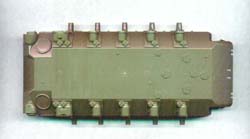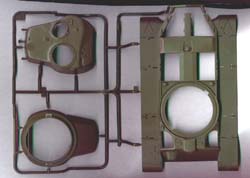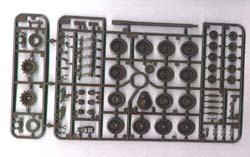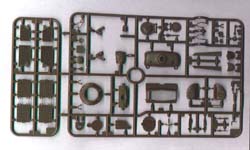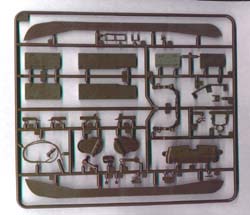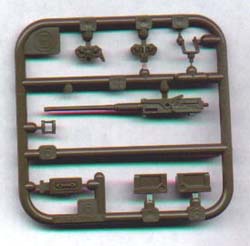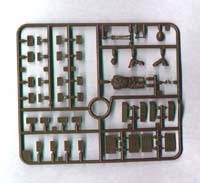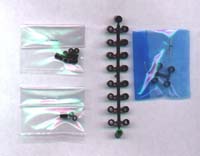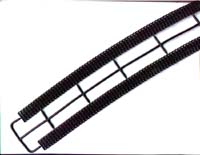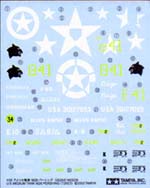TAMIYA 1/35 U.S. MEDIUM TANK M26 "PERSHING" (T26E3)
KIT NO. 35254
MSRP: $44.00
GREATMODEL'S PRICE: $33.00
|
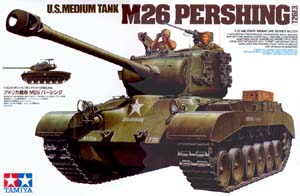 |
HISTORY
The Pershing was a U.S. medium tank. In 1942 the U.S. Armoured Force
realized that the 75mm (2.95-in.) gun, on the M4 tank, would soon have
to be improved upon. They pressed for the adoption of the 90mm (3.54-in.)
gun, but this was refused since the Sherman turret was not large enough
to take the 90mm with its larger breech and recoil system.
When faced with the same problem the British had fitted the 17-pdr.
gun to the Sherman with conspicuous success, but – for reasons never
publicly revealed – the U.S. Ordnance Department refused to have
anything to do with the 17-pdr. They chose instead to develop a completely
new tank to accommodate the 90mm gun. The resulting T20 series was approved
in May 1942 and a great deal of time was spent in trials of various engine
and transmission systems, suspensions, and different guns and mountings.
From all these deliberations the T26 appeared in 1944. It had an automatic
transmission, torsion-bar suspension, a 610mm (24-in.) wide track, and
a high-velocity 90mm gun. The Armoured Force requested manufacture of
this on a high priority, but the Army Ground Force refused, considering
that a 76mm (3-in.) gun was all that was needed. However, by late 1944,
reports from Europe made it obvious that the 76mm gun was not the success
it's designers had hoped for.
After a considerable struggle between the Armoured Board, the Ordnance
Department, and the Army Ground Forces, the T26 (now classified as a heavy
tank) was put into production. In January of 1945 the first 30 were shipped
to Europe where they were assigned to the 3rd and 9th Armored Divisions
of the 21st U.S. Army, and were used by the latter unit in the advance
on the Ramagen Bridge on March 7th, 1945.
That same month, the design was standardized as the M26. By the end
of March, 210 had been shipped, and by the end of the war there were 310
in Europe. However, only the first 20 had been used in combat. Twelve
were shipped to the Pacific Theatre, for use on Okinawa, but the war had
ended before these were ready to use there.
A total of 2,428 M26's were produced, at a unit cost of about $81,000.00
each. In May of 1946 they were reclassified once more as medium tanks.
In the early 1950's they saw action in Korea, but by that time many of
them had been withdrawn from service and fitted with new engines, transmissions,
and guns....to turn them into M47 medium tanks.
The M26 chassis formed the basis for a number of self-propelled equipments,
most of which were never taken into service, and the experiences gained
with these vehicles formed the foundation for the subsequent U.S. development
which led to the M60 series of tanks.
TECH DATA:
Weight: 41.7 tonnes
Length: 6.32m (20ft. 9in.)
Hull Width: 3.5m (11ft. 6in.)
Height: 2.77m (9ft. 1in.)
Armament: One 90mm (3.54-in.) M3 gun with 70 rounds carried.
Powerplant: Ford V-8 gasoline engine of 500 BHP at 2600 RPM.
Speed: 48 Km/h (30 Mph.)
Range: 175 Km (110 Miles)
Crew: 5
WHAT'S IN THE BOX?:
The kit comes in a large (15" x 9 1/2") tray and lid type box. The box
art and side panels show three of the color schemes offered in the kit.
There is also some smaller pictures, on the side panels, of the two crew
members posed in the turret hatches of a built up kit and some color drawings
of the machine-gun's folded tripod, ammo cases, and a K-ration box.
The kit contains six cello bags of olive green colored plastic parts
trees.
There are two identical letters "A" and "B" trees. Each of these trees
holds one each "A" and "B" trees that are co-joined. Tree "A" holds the
road wheels, return rollers, suspension arms, headlight guards, tow cable
ends, main gun barrel halves, muzzle break halves, etc. (62 parts per
tree). Letter "B" tree holds the drive sprockets and some spare track
links etc. (7 parts per tree).
Lettering now jumps to the letter "D" tree. This tree holds the turret
top and bottom and the hull top (3 pieces). The turret top has some really
nice raised casting serial numbers molded into it and a beautiful cast
texture. Nice job Tamiya!
Letter "E" tree is next. It holds the flexable 50cal. machine-gun with
it's ammo box and mount parts. (8 parts here) This tree is in the same
cello bag as the bathtub shaped hull bottom piece.
Trees "F" and "G" are also co-joined together. "F" holds the mantle,
hatch lids, one figure's parts (he is only molded from the waist up),
and numerous other small fittings. Letter "G" holds 8 engine deck doors.
(42 parts).
Letter "H" tree holds the fender side panels, tow cable, and numerous
other panels etc. (31 parts)
Lettering now jumps again to the letter "X" tree. This one holds ammo
and K-ration boxes, the second crew figure (molded from the knees on up)
a steel helmet, wire cutters, binoculars etc. (40 parts)
Next is the tree of black vinyl rubber-band style treads. Molding on
these is quite good on both sides and the instructions say that these
are GLUEABLE...as opposed to the old way of heat welding them together
into a loop.
A small cello bag holds 22 black vinyl poly-caps (to be used on the
suspension arms) and some metal screws and nuts. This metal hardware,
I gather, is to used to bolt the model down to a diorama base over rough
terrain to articulate the suspension and make the tank conform to the
ground work.
A final cello bag holds the decal sheet.
The instructions consist of a 10 1/4" x 6 3/4" stapled booklet of 16
pages.
Page one has the box art, in black and white, at the head of it, followed
by the vehicle's history in Japanese and Chinese. There is a small map
of the Ramagen Bridge area and, at the foot of the page, some tech data
which includes English.
Page two continues with the history, still in Japanese and Chinese.
There is a time-line drawing which illustrates the kind of tanks used
during those years and a map of Korea. There are also some drawings of
G.I.s and North Korean soldiers.
Page three continues on with the history, this time in English, German,
and French. A small action drawing, of a Pershing firing its gun, while
passing a knocked-out T-34, appears at the bottom of this page.
Page four begins with general instructions concerning the kit and a
list of tools (which are illustrated) that will be needed to complete
the kit. The bottom of this page shows the first assembly step.
Pages five through 13 give us the remaining 22 assembly steps.
The bottom of page 13 gives us painting instructions.
Pages 14 to 16 give us four different paint schemes:
-
Company B, 1st Tank Battalion, U.S. Marines, September 1950, Inchon,
Korea.
-
Number 9 tank, Company A, 18th Tank Battalion, 8th Armored Division,
1945 Czechoslovakia. This tank has the slogan "ALLED KAPUT" on its
sides. It also has a black panther head adorning the glacis plate
and the rear of the fender skirts.
-
Number 10 tank, Company E, 67th Armored Regiment, 2nd Armored Division,
April 1945, Germany. This tank is fairly plain with just stars and
numerals.
-
Number 5 tank, 2nd Platoon, Tank Company F, 33rd Armored Regiment,
3rd Armored Division, February 1945, Elsdorf Germany. This tank has
the slogan "FIREBALL" on its fender skirts and is featured on the
main box art.
The bottom of page 16, of the instructions, shows illustrations of
the metal hardware in the kit, followed by a reply coupon to order any
missing parts from the kit.
A second small sheet, included in the kit, shows illustrations of all
the different armor and aircraft that were used in the Korean War. On
the reverse side of this sheet are box arts of the kits that Tamiya produces
of these same Korean combatants.
Conclusion
The kit is highly detailed and molded in Tamiya's usual high quality.
It has movable suspension, accomplished with the use of the provided poly-caps
and metal hardware. Hatches can be posed either open or closed too. All
that metal hardware will be interesting to see how it works. I liked the
inclusion of various extra ammo boxes and the K-ration box.
Highly recommended.
As a footnote, DML Dragon also did two boxings of the Pershing in 1/35th
scale. One was a WWII version and the other a Korean one. What the darn
difference was in these, I do not know? Also how DML's Pershings compare
to this new Tamiya one is not known to me either. However, I would probably
guess that the DML ones had individual tread links as apposed to Tamiya's
rubber band ones. Do you think Tamiya will ever initiate individual links
in their kits? Would be nice huh?
I bought this kit from Greatmodels.
|








|

